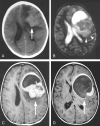Astroblastoma: radiologic-pathologic correlation and distinction from ependymoma
- PMID: 11847049
- PMCID: PMC7975267
Astroblastoma: radiologic-pathologic correlation and distinction from ependymoma
Abstract
Astroblastoma is a rare primary glial tumor with a characteristic appearance on neuroradiologic images. Typically, astroblastomas are large, lobulated, peripheral, supratentorial, solid, and cystic masses with relatively little associated vasogenic edema and tumor infiltration for their large size. The solid component of the mass has a bubbly appearance and a T2 signal that is isointense to gray matter. Punctate calcifications are often present. Neuroradiologists should be familiar with the characteristic appearance of this tumor.
Figures






References
-
- Pizer BL, Moss T, Oakhill A, Webb D, Coakham HB. Congenital astroblastoma: an immunohistochemical study. Case report. J Neurosurg 1995;83:550–555 - PubMed
-
- Bailey P, Cushing H. Classification of the Tumors of the Glioma Group. Philadelphia, Pa: Lippincott;1926. :83–84; 133–136
-
- Bailey P, Bucy PC. Astroblastomas of the brain. Acta Psychiatr Neurol 1930;5:439–461
-
- Bonnin JM, Rubinstein LJ. Astroblastomas: a pathological study of 23 tumors, with a postoperative follow-up in 13 patients. Neurosurgery 1989;25:6–13 - PubMed
MeSH terms
LinkOut - more resources
Full Text Sources
Medical
